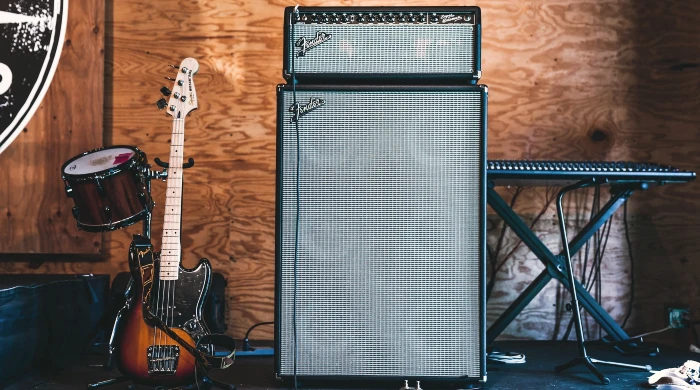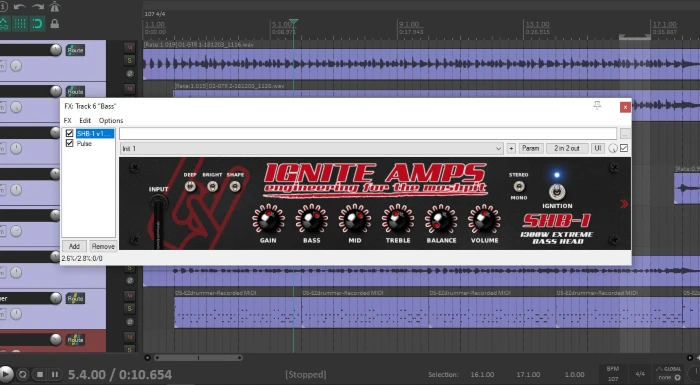Bass is the power of any song. And to get a good low-end that makes a song more powerful, you need to record bass guitars properly.
There are many techniques and methods of bass guitar recording. You can use real amps, bass amplifier simulators, record DI bass tracks, etc.
But whatever method you use, you have to record your bass the best way possible. Here I am to explain how to record bass in two different ways.
Recording A Bass Guitar: Prerequisites
Before you start recording bass guitar, there are several crucial points to check. You have to be prepared for recording.
If you are not ready to record bass guitar, later it will be impossible to make it better. So, try to do the things listed here before you start the bass guitar recording session.
- Change Old Strings – The first thing you need to do is to change old bass strings. New strings will sound much better. Your bass will have a fresh and clean sound. Never record your bass guitar with old strings.
- Set Up Action and Intonation – Next, you need to adjust the action and intonation of your bass. Low action will help you to play smoother and cleaner. And without a good intonation, your notes won’t sound in tune. Always adjust intonation and action before recording.
- Master Your Part – A very important step is to practice your part and master it. Never start recording unprepared. You have to know your part very well to play and record it perfectly.
- Prepare Recording Environment – The last thing to do before the bass recording session is to prepare for it. Open the project in DAW, connect the bass and audio interface, create a bass track, and test the volume.
After you do all the things mentioned above, you are ready to start recording bass guitar.
How To Record Bass Guitar With Amps

First, let’s learn how to record a bass guitar with a real bass amplifier. The approach can be different when you record with a real amp. So, it’s important to explain it separately.
There are similarities between a real bass amp and a bass amp sim recording. But in the end, both need a separate approach.
Also, when you start recording a song, it’s important to know what bass recording method you are using. It will help you a lot in the future.
Create Bass Guitar Tone
The first and most important thing is to create a good bass guitar tone. The best way to create a great tone is to listen to a song and understand what type of low-end it needs.
To create a bass tone, you have to choose the bass guitar and amp first. Your final result will depend on the gear and your playing. So, choose the bass and amp type wisely.
If you recording clean parts, choose the best clean-sounding bass and amp. If you want a dirty sound, choose the bass and amp that have great overdrive sound. It all depends on the context.
Also, a very important thing to remember when recording bass with a real bass amp. You need to create and record the exact same sound you want to hear in your song. If you want to record a dirty sound, create a dirty sound.
Sometimes people record clean amp sound and then add distortion plugins. Nothing is wrong with that but then there’s no point in using a real amp. You could have used an amp sim.
The reason why we use real amps when we record bass guitar is that we like the sound of that amp. So, why not record it? Use the power of a real amp.
Try to dial the sound you like and think will work great with the song you are working with. And that’s the crucial part of the bass recording.
The goal isn’t to create the best bass tone in the world. But it should fit in the song. You may dial in an amazing bass guitar tone but when you play it with the song, it won’t sound good.
So, always try to create a tone that will be perfect for that particular song. It must blend with other instruments perfectly.
Record One Bass Track
Recording bass with a real amp has many benefits. It has a real, natural sound. But also you only need to record one bass track. There is no need to have another bass track like DI.
The whole point of using a real bass amp is that it sounds awesome. So, there is no need for additional bass tracks. Just create one bass track and record it.

Of course, there are no rules in music recording and you can do whatever you want to do. But in general, a minimal approach is the best. Especially when you use real amps.
But what you want to do is to play your bass part perfectly. Your playing must be tight and on time. That’s why you need to practice and master your bass parts before you start the recording sessions.
Record From Start To Finish
Lastly, a small detail. When you record bass or any other instrument, try to play and record it from start to finish. Don’t record part by part. Play the whole song.
Even if you make mistakes, don’t stop. Just finish the whole song and you can rerecord bad parts later. Fortunately, with modern digital audio workstations, it’s easy to edit sections and record them again.
When you record your part from start to finish, it will sound more natural. The flow will be better. This way your song will sound like a live band playing.
So, play and record the whole song as best as you can. Edit mistakes later. But try to make as few mistakes as you can.
How To Record Bass Guitar With Amp Sims

Now, it’s time to find out the bass recording method with amp sims. The technique is a little different and complex. But for best results, we have to approach it differently.
Of course, you can use your favorite bass amp sim as a real amp. Choose your favorite amp and cabinet from the library, dial in the sound, and record on one track.
But there is a better way to record bass guitar with a simulator. You will have a better tone and you will be able to customize it later.
Create A Clean Bass Tone
The first thing to do when recording bass with bass amp sims is to create a clean tone. Although today we have very high-quality and realistic-sounding applications, they still do not sound as good as real amps.
The clean sound is great but distortion or overdrive channels are not as good. So, it’s better to record clean sound and add distortion later with the help of plugins.
Just create the best clean tone for your bass. And remember that it must sound great with the whole song. It must sit perfectly with other instruments.
Record Bass With DI Track
Here comes the power and good part of bass applications. When you record bass with amp sims, you need to record two tracks.
The first track will be the amp sim track, the sound you created. But the second track will be the DI tracks. A DI track is when you record your instrument’s signal without any interference and you can use a DI box for it.
It’s very easy to record the DI track. Create two tracks, insert amp sim on one track and the second track should be clean. So, it will have a pure bass tone. Without any amp or other plugin.

Turn on the record button on both tracks and record your bass part. This way you will have two identical bass recordings. One with an amp sound and one with a clean bass tone.
Recording a DI track and having two separate bass tracks have many benefits that you can use in the mixing process.
The Bass DI track has many benefits and you can use it to your advantage. You can use these benefits for bass tone or during the bass mixing process.
When you have a bass DI track, you can blend the two sounds and create a richer and unique bass tone.
You can add an overdriven sound to a DI track and blend it with a clean sound. Or use only low frequencies of a clean bass tone and high frequencies of a dirty bass tone.
There are countless ways to use DI track benefits to your advantage. And that’s what makes the bass amp sim recording method special. You have more options and flexibility regarding sound and mixing.
But a real bass amp has its own merits. It’s natural-sounding, has more juice, and has rich harmonics. And of course, you can create a DI track with a real amp and do the same thing.
Remember that there are no rules in music recording. You have to do what is best for the song and do experiments. You have total freedom.
Conclusion
Now you understand how you can record bass guitars in two different ways. You can use which one you like or both. Every project requires a different approach and it’s good to know different bass recording techniques.
Some songs may require a real amp sound and a simple approach. But some songs may need more complex, diverse sounds. When you know more recording methods, you will create better recordings and songs.
